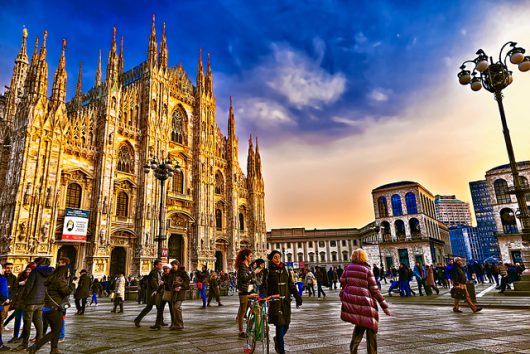Top 10 Facts About Living Conditions in Italy

Italy, one of the biggest tourist destinations in the world, has been ranked relatively low in US News’ 2018 Best Countries report. Italy placed 15th in a list of 80 countries following the Nordic countries, Canada, the United States, and the United Kingdom. This came as a shock to many non-Italians, as Italy is often idealized and tourism often highlights the best of the country, not its realities. To understand this ranking, here are 10 facts about living conditions in Italy:
10 Facts About Living Conditions in Italy
- Housing
Housing in Italy, particularly in the northern and center cities, is very expensive. Cities like Milan and Rome are some of the most expensive cities, not just in Italy, but in the world: Milan ranks 50th and Rome 58th on the list of most expensive cities in the world. Despite the region—north, center, or south—the cost of housing greatly increased from 21 percent in 2005 to 24 percent in 2014 and has stayed above this level since. This increase was actually noted by the Organisation for Economic Co-operation and Development (OECD) as one of the strongest rises in the OECD. - Income
General income in Italy is relatively low and has been turbulent since 2005. Moreover, between 2010 and 2014, the average household net wealth fell by 18 percent. Though there were signs of real recovery in 2015, household net-adjusted disposable income fell again in 2016 and was reportedly 10 percent lower than in 2005. This massive decline has also been noted to be one of the largest falls in the OECD. - Poverty
There is a massive gap between the wealthy and the poor in Italy, both geographically and financially. Geographically, much of the wealthy live in the north of Italy, while many of the poorer Italians live in the south. Moreover, as the OECD has noted, Italian income is distributed the most unevenly across Italian households than any other country. The OECD states that this is due to the fact that the average income of those in the top quintile is almost six times higher than those in the bottom quintile. However, the poverty level in Italy is growing. 14 percent of households across the country were labeled as income poor in 2016. - Gender Equality
The gender inequality in Italy is one of the biggest reasons behind poor life quality ratings. It was found that in Italy, women are 15 percent more likely to be unemployed and, even when employed, they are 75 percent more likely to be employed in low-paying jobs. As the OECD has noted, the gender gap in Italy is one of the largest compared to other countries under inspection by the OECD. - Health
Italy’s healthcare system, the Italian National Health Service (SSN), is one of the country’s redeeming facets. The SSN is a universal, egalitarian public system guaranteeing assistance to all citizens. However, its one downfall is that the wait time for examination is often lengthy; it can reach a couple months, even with an urgent case. Nevertheless, the overall health of Italy has increased by 7.5 points since 2005, which places the country just below the OECD average in health. - Environmental Quality
Although Italy is known for its beautiful scenery and landscapes, overall air pollution increased by 3 percent between 2005 and 2013 and has been rising since. Much of this pollution is due to poor sanitization; a vicious cycle has been created where poor sanitation creates pollution and pollution generates poor sanitation. Moreover, the OECD has received many complaints in the last few years about decreasing water quality in Italy. - Civic Engagement
There is an overall unrest with Italian civics. This is more substantial in the younger generations, but Italian civics has nevertheless seen a general decrease in participation. Voter turnout, like many other countries in the OECD, has decreased in Italy. The last known statistic is that 75 percent of Italy’s population voted in the 2013 general elections, which was significantly less than the 84 percent recorded in 2006. Moreover, a staggering 89 percent of Italians believe that there is widespread corruption across their government, which is much higher than the OECD’s average of 59 percent who believe this. Finally, perhaps as a result of the increasing belief in widespread corruption, only 38 percent of Italians say that they have confidence in the government. - Education
Although OECD’s recent data in Italy’s upper education system is unassessable, there are a few positives to highlight. Between 2014 and 2016, the rate of people in upper education increased by just under one percent and has been slightly increasing since. Additionally, the gender gap in education outcomes in Italy has decreased and now seems to favor women. - Employment
Italy’s employment rate has not improved substantially since 2005. The unemployment rate, currently at 12 percent, is currently reported to be three times higher for younger generations as opposed to the current middle-aged generation. The unemployment rate is the third highest in the entirety of the OECD. - Life Satisfaction
In the past decade, the Italian population’s life satisfaction has fallen from 6.7 to an average of 5.9 on a scale out of 10. This is significantly lower than the OECD’s average and causes concern as it continues to decrease.
These facts about living conditions in Italy highlight that there is much room for improvement. Although much of the country sees a high amount of tourism, it isn’t enough to generate a steady economy or to close the large gap between the poor and wealthy. There is still hope for Italy, but a substantial amount of work remains to be done.
– Isabella Agostini
Photo: Flickr
